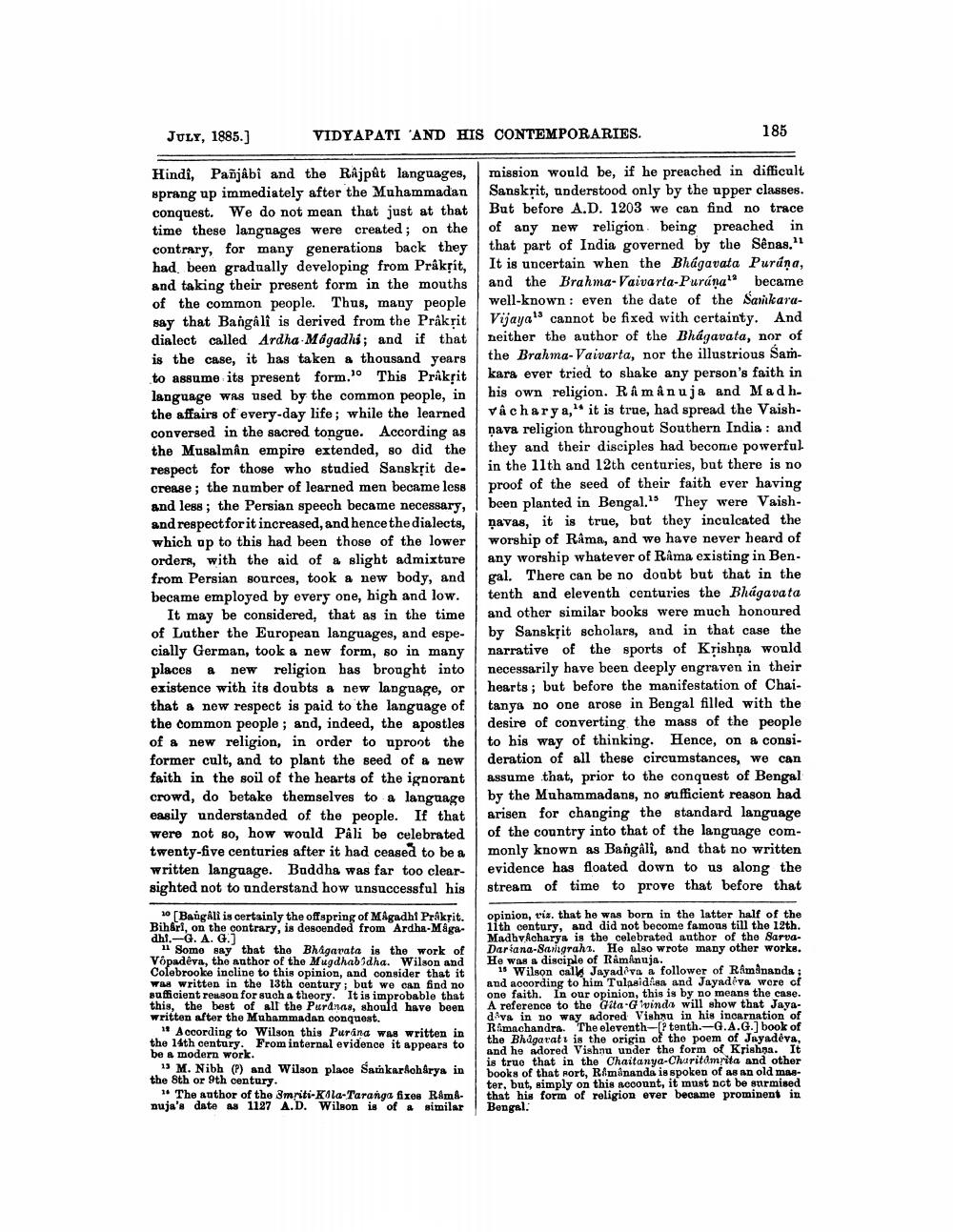________________
JULY, 1885.)
VIDYAPATI AND HIS CONTEMPORARIES.
185
Hindi, Pañjábi and the Rajpat languages, mission would be, if he preached in difficult sprang up immediately after the Muhammadan Sanskrit, understood only by the upper classes. conquest. We do not mean that just at that But before A.D. 1203 we can find no trace time these languages were created; on the of any new religion being preached in contrary, for many generations back they that part of India governed by the Sênas." had been gradually developing from Prakrit, It is uncertain when the Bhagavata Purána, and taking their present form in the mouths and the Brahma-Vaivarta-Purána'became of the common people. Thus, many people well-known: even the date of the Sarikarasay that Bangali is derived from the Prakrit | Vijaya's cannot be fixed with certainty. And dialect called Ardha-Magadhs; and if that neither the author of the Bhagavata, nor of is the case, it has taken a thousand years the Brahma-Vaivarta, nor the illustrious Samto assume its present form. This Praksit kara ever tried to shake any person's faith in language was used by the common people, in his own religion. Râm ânuja and Madhthe affairs of every-day life; while the learned Vâ charya," it is true, had spread the Vaishconversed in the sacred tongue. According as nava religion throughout Southern India : and the Musalman empire extended, so did the they and their disciples had become powerful respect for those who studied Sanskrit de- in the 11th and 12th centuries, but there is no crease; the number of learned men became less proof of the seed of their faith ever having and less; the Persian speech became necessary, been planted in Bengal." They were Vaishand respect for it increased, and hence the dialects, navas, it is true, bat they inculcated the which op to this had been those of the lower worship of Ráma, and we have never heard of orders, with the aid of a slight admixture any worship whatever of Rama existing in Benfrom Persian sources, took a new body, and gal. There can be no doubt but that in the became employed by every one, high and low. tenth and eleventh centuries the Bhagavata
It may be considered, that as in the time and other similar books were much honoured of Luther the European languages, and espe- by Sanskrit scholars, and in that case the cially German, took a new form, so in many | narrative of the sports of Krishna would places a new religion has brought into necessarily have been deeply engraven in their existence with its doubts a new language, or hearts; but before the manifestation of Chai. that a new respect is paid to the language of tanya no one arose in Bengal filled with the the common people ; and, indeed, the apostles desire of converting the mass of the people of a new religion, in order to uproot the to his way of thinking. Hence, on a consiformer cult, and to plant the seed of a new deration of all these circumstances, we can faith in the soil of the hearts of the ignorant assume that, prior to the conquest of Bengal crowd, do betake themselves to a language by the Muhammadans, no sufficient reason had easily understanded of the people. If that arisen for changing the standard language
arisen for changing the sta were not so, how would Pali be celebrated of the country into that of the language comtwenty-five centuries after it had ceased to be a monly known as Bangals, and that no written written language. Buddha was far too clear- evidence has floated down to us along the sighted not to understand how unsuccessful his stream of time to prove that before that
10 [Bang All is certainly the offspring of MAgadht Prakrit. Bihari, on the oontrary, is descended from Ardha-Magadhl.-G. A. G.)
1 Somo say that the Bhagarata is the work of Vôpadeva, the author of the Mugdhabidha. Wilson and Colebrooke incline to this opinion, and consider that it Was written in the 13th century; but we can find no sufficient reason for such a theory. It is improbable that this, the best of all the Puranas, should have been written after the Muhammadan conquest.
1 According to Wilson this Puring was written in the 14th century. From internal evidence it appears to be a modern work.
13 M. Nibh (P) and Wilson place Sathkarkohárya in the 8th or 9th century.
1. The author of the Smriti-Kola-Taranga fixes Ramspuja's date as 1127 A.D. Wilson is of similar
opinion, vis, that he was born in the latter half of the 1ith century, and did not become famous till the 12th. Madhv Acharya is the celebrated author of the SarvaDariana-Sangrah. He also wrote many other works. He was a disciple of Ramanuja.
15 Wilson call Jayadiva a follower of Rámånanda ; and according to him Tulasid sa and Jayadeva were cf one faith. In our opinion, this is by no means the case. A reference to the Gita-Givinds will show that Jayadays in no way adored Vishnu in his incarnation of Ramachandra. The eleventh- tenth.-G.A.G.] book of the Bhagarats is the origin of the poem of Jayadeva, and he adored Vishnu under the form of Krishna. It is true that in the Chaitanya-Charitamrita and other books of that port, Rimananda is spoken of as an old master, but, simply on this account, it must not be surmised that his form of religion ever became prominent in Bengal




